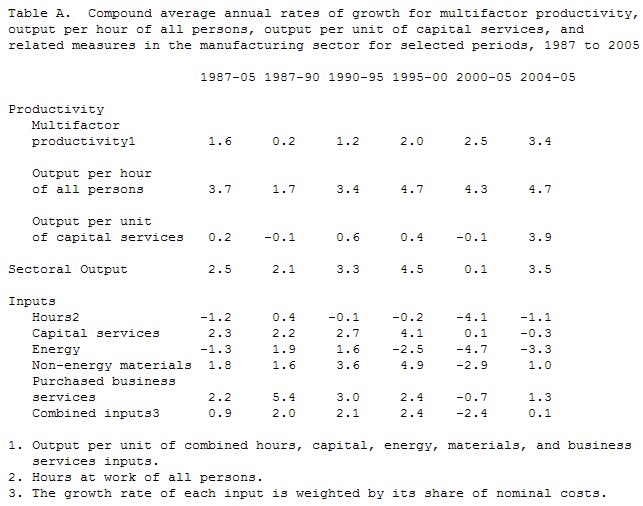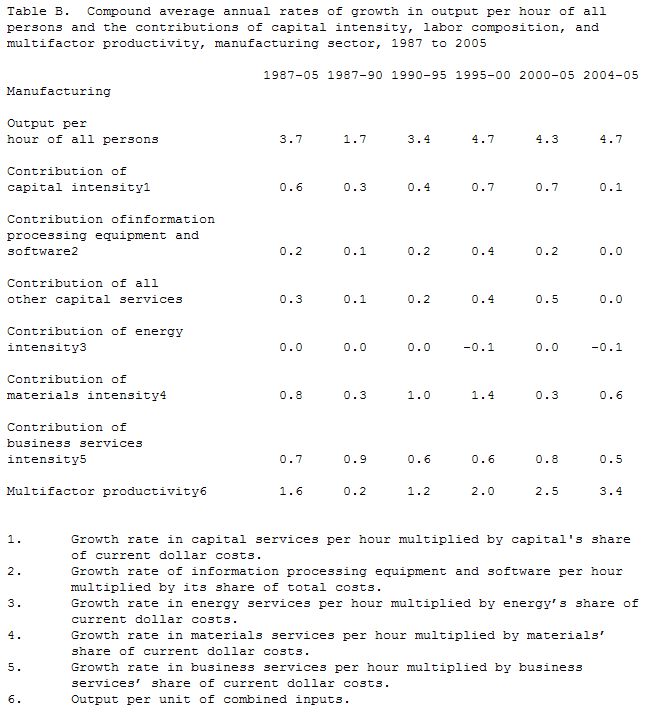3.4 percent in the manufacturing sector and
3.3 percent in the durable goods manufacturing sector and
3.2 percent in the nondurable goods manufacturing sector.
At 3.4 percent, multifactor productivity growth in the manufacturing sector slowed somewhat compared to 2004 (3.8 percent). This was due to a deceleration in durable goods manufacturing productivity growth from 4.5 percent to 3.3 percent. A small acceleration in nondurable goods manufacturing productivity growth from 2.5 percent to 3.2 percent partially offset the slower growth of multifactor productivity in durable goods manufacturing.
Multifactor productivity is designed to measure the joint influences on economic growth of technological change, efficiency improvements, returns to scale, reallocation of resources, and other factors, allowing for the effects of capital, labor, and in the case of the manufacturing sector, intermediate inputs (energy, materials, purchased business services). Multifactor productivity, therefore, differs from labor productivity (output per hour worked) measures that are published quarterly by BLS since it includes information on capital services and other data that are not available on a quarterly basis.

Manufacturing sector
Multifactor productivity in the manufacturing sector rose 3.4 percent in 2005 (see table A). This is the fourth consecutive year that multifactor
productivity rose in manufacturing. The multifactor productivity gain in 2005 reflected a 3.5 percent increase in sectoral output and a 0.1 percent increase in combined inputs, which, while modest, was the first
increase since 1999. Capital services declined 0.3 percent in 2005, after having also declined in 2004. Hours declined 1.1 percent in 2005, materials rose 1.0 percent and purchased business services rose 1.3 percent.
Historical trends in manufacturing
Labor productivity (output per hour worked) differs from multifactor productivity (output per unit of combined inputs) in the treatment of both capital and intermediate inputs (energy, materials, and business services). Labor productivity measures do not explicitly account for the effects of capital nor do they account for changes in the effects of intermediate inputs on output growth. As a result, changes in input intensity (the input-hours ratio) can influence labor productivity growth. In contrast, multifactor productivity treats capital and intermediate inputs as explicit factors of production and, therefore, is net of changes in input intensity. Historical trends in labor productivity growth can be viewed as the sum of five components: multifactor productivity growth, and the contribution of the intensity of the following inputs: capital, energy, materials, and business services (see table B).
The contribution of input intensity equals the change in the input-hours ratio multiplied by the input's cost share. Historically the labor share is about a third of total cost, the capital share about a sixth, the materials share a little over a fourth of total cost, and the business services share a little less than a fourth. The energy share is historically only about 3 percent of total cost.
Multifactor productivity in manufacturing grew 1.6 percent annually between 1987 (the starting point of the series) and 2005 (see table A). Sectoral output increased at a 2.5 percent annual rate over the period, and combined inputs rose an average of 0.9 percent per year. Of the 3.7 percent growth rate in output per hour (labor productivity), 1.6 percent can be attributed to increases in multifactor productivity, 0.6 percent to the contribution of capital intensity, 0.8 percent to changes in materials intensity, and 0.7 percent to changes in business services intensity (see table B). The remaining input, energy, was a very small share of total inputs; therefore, it made no discernable contribution to output per hour.
From 1995 to 2000, multifactor productivity in manufacturing accelerated more rapidly than in previous periods, averaging growth of 2.0 percent per year. Sectoral output growth increased to an average of 4.5 percent per year (see table A), while combined inputs advanced at an average of 2.4 percent per year, a slightly higher rate than in the early 1990s. In the 2000-2005 period, multifactor productivity growth increased faster than in the 1995-2000 period, averaging growth of 2.5 percent per year. Labor productivity slowed to a still-robust average annual growth rate of 4.3 percent per year. The contribution of capital intensity growth was unchanged in the 2000-2005 period from the 1995-2000 period, growing at an average annual rate of 0.7 percent (table B). The contribution of other capital services rose 0.5 percent during
the 2000-2005 period, while the contribution of information processing
equipment grew 0.2 percent. The contribution of materials dropped to an average growth rate of 0.3 percent from 1.4 percent in the 1995-2000 period, while the contribution of business services intensity accelerated slightly, averaging 0.8 percent.
Among detailed manufacturing industries, most durable goods and nondurable goods industry groups experienced multifactor productivity gains in 2005. The exceptions were petroleum and coal products, and
furniture and related products. In these two industries multifactor
productivity growth declined in 2005. The manufacturing industries that showed the largest multifactor productivity growth in 2005 were textile mills and textile product mills, which increased 9.7 percent, and printing and related support activities, with an 8.7 percent increase.

Over the full 1987-2005 period, multifactor productivity advanced most rapidly in the computer and electronic products industry. This industry’s 9.6-percent average annual growth rate during this period is 7.8 percentage points higher than the industry with the next highest growth rate, textile mills and textile product mills. In the 1995-2000 period, multifactor productivity grew very rapidly in the computer and electronic products industry, 15.8 percent per year. In the 2000-2005 period, the growth rate slowed to 6.3 percent. Three industries experienced a decline in multifactor productivity over the 1987-2005
period: food, beverage and tobacco products; machinery; and electrical equipment, appliances and components.





